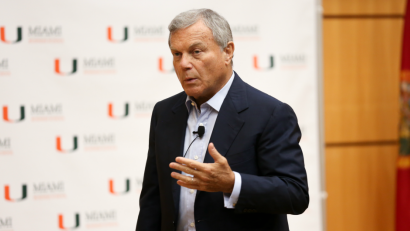“People tell me that Google and Facebook must be eating your lunch, but in fact they are our first and third largest media partners,” said Sorrell in a talk October 5 as part of the School’s Distinguished Leaders Lecture on Series. “But one of the most important trends in the marketing sector is the continued low cost of capital, which makes it easier for newcomers to compete with the world's top brands,” to his audience of students, alumni and others in the community.
In introducing Sorrell, Dean John Quelch said WPP has a long history of innovation and market leadership. “WPP was one of the first major agencies to understand the importance of emerging economies, investing in digital, and profiting from media buying activity as well as developing creative content,” Quelch said.
Back in 1985, Sorrell and a stockbroker partner purchased Wire and Plastic Products, a shell company traded on the London stock exchange, and used it build a powerful worldwide communications company. Today, WPP operates through 12 verticals with dozens of brand names in 113 countries. The group’s annual billings of about $75 billion are more than 25 percent of the world market.
“We are in the brand business, and our research shows that strong brands generate superior shareholder returns,” Sorrell said. “Branding has a maximum impact on sales growth, which is crucial to driving share prices.”
Sorrell said WPP’s strategic priorities include a focus on bringing its verticals into horizontal alignment, and investing in digital media, consumer research and high-growth markets. “The next billion consumers will not come from the U.S. and Western Europe but from Asia, Latin America and Africa,” he said. “We want those markets to grow to 50 percent of our global business.”
For multinational companies, the power of a global organization combined with local presence is increasingly important, Sorrell said. However, regional management, such as an Asia-Pacific team, is facing pressure to justify its role. He also noted that the low-cost, low-growth financial environment will continue to drive consolidation in many industry sectors.
Looking at other global market trends, Sorrell said the supply of goods is higher than demand in most industries. However, the reverse is true for the aging worldwide workforce. “The war for talent will become increasingly competitive,” he said. “The UM School of Business will continue to play an important role in educating new business professionals.”
The Art of the Deal: How to Negotiate Complex Mergers and Acquisitions in 2017
Scott A. Barshay
Global Head, Mergers & Acquisitions Practice
Paul, Weiss
LEAN MORE/RSVP
Ming-Po CAI
Founder and President, Cathay Capital Private Equity
LEARN MORE/RSVP
November 28, 2017
Sunil Gupta
Edward W. Carter Professor of Business Administration and
Chair, General Management Program
Harvard Business School
December 5, 2017
Michael Schrader
Co-Founder and CEO
Vaxess Technologies Inc.
January 16, 2018
David Kenny
Senior Vice President
IBM Watson and Cloud Platform
February 20, 2018
William McNabb
Chairman and CEO
Vanguard Group Inc.
March 22, 2018
Gail McGovern
President and CEO
American Red Cross

